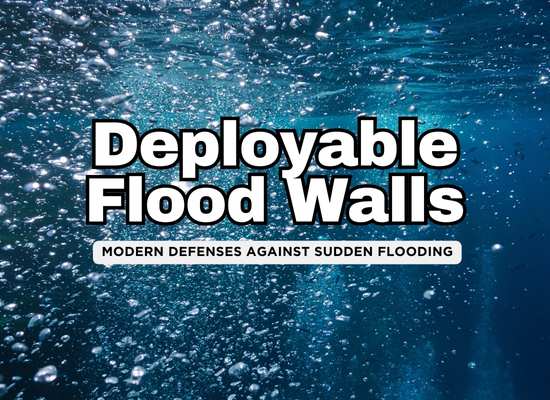Floods are among the most devastating natural disasters, causing billions in damage and displacing communities worldwide. When disaster strikes, emergency flood walls play a crucial role in protecting infrastructure and saving lives. Unlike permanent levees or seawalls, these barriers are designed for quick deployment, offering temporary yet effective protection against rising waters.
From water-filled dams to modular panel systems, modern flood walls have evolved to be faster, stronger, and more adaptable. Here’s a deep dive into four of the most effective emergency flood wall systems, starting with one of the most innovative: water-filled barriers.
1️⃣ Water-filled barriers: Harnessing water to stop water
Water-filled barriers are one of the most efficient and adaptable flood prevention solutions. These flexible, heavy-duty tubes or dams are quickly filled with water to create a stable, high-strength barrier. Instead of relying on traditional materials like sandbags, they use the very element they are designed to block—water—to form a strong and stable defense.
Water-filled barriers come in different sizes and can be stacked or linked together to create a continuous flood wall. They are lightweight and easy to transport when empty, making them an ideal solution for both urban and rural flood emergencies.
Advantages:
- Fast deployment compared to sandbags
- Reusable and environmentally friendly
- Can be customized to different flood heights
- Minimal labor required for installation
Limitations:
- Requires a water source for filling
- Not suitable for rocky or uneven terrain
- Can be punctured if not properly maintained
These barriers are used worldwide, including in hurricane-prone areas and flood-prone urban centers. The Tiger Dam system is a well-known example that has been deployed in multiple emergency situations to protect homes, businesses, and critical infrastructure.
2️⃣ Modular panel systems: Strong, reusable, and easy to install
Modular panel systems provide a rigid and highly durable alternative to traditional flood barriers. These systems consist of interlocking panels, typically made of steel, aluminum, or reinforced plastic, which are assembled on-site to create a flood-resistant wall. The panels are designed to be lightweight enough for rapid deployment while offering strong resistance against floodwaters.
One of the key advantages of modular panel systems is their versatility. They can be installed in various environments, from city streets to industrial areas, and are often used to protect critical infrastructure such as power plants, subways, and commercial buildings. Some systems are anchored into the ground, while others use weighted bases to remain stable without permanent fixtures.
Advantages:
- Extremely durable and can withstand high water pressure
- Reusable and long-lasting, making them cost-effective
- Customizable to different heights and flood scenarios
- Easy to install and remove when the flood threat is over
Limitations:
- Requires storage space when not in use
- Can take longer to set up than inflatable or water-filled barriers
- Higher initial cost compared to other temporary flood barriers
A well-known example is TrapBag, which features a series of interlocking flood barriers that provide rapid protection with minimal setup. These systems have been deployed in cities and along coastlines where fast response and strong flood defense are critical.
3️⃣ Inflatable barriers: Lightweight and quick to deploy
Inflatable barriers are one of the fastest flood protection solutions available. These barriers are air-filled and designed to be rapidly deployed in emergency situations. They are typically made from heavy-duty, puncture-resistant materials and can be inflated using air pumps or compressed gas systems.
One of their biggest advantages is ease of transport and setup. Unlike sandbags or modular panel systems, inflatable barriers can be stored compactly and expanded to full size within minutes. They are often used in urban environments, where speed and flexibility are crucial in flood response efforts.
Advantages:
- Extremely lightweight when deflated, making storage and transport easy
- Rapid deployment, often in minutes
- Can be used in a variety of terrains, including paved roads and open fields
- Minimal manpower required for installation
Limitations:
- Less durable than rigid flood barriers
- Vulnerable to punctures if not handled properly
- Requires reliable inflation equipment and anchoring to stay in place
Inflatable flood barriers are commonly used in emergency response situations, including storm surge defense and flash flood prevention. Some models can also be filled with water instead of air to add extra weight and stability.
4️⃣ Sandbag alternatives: Faster, stronger, and more efficient
Traditional sandbags have been used for centuries as a flood defense, but modern innovations have led to more effective and time-saving alternatives. These sandbag replacements include self-expanding flood barriers, water-activated flood bags, and stackable flood blocks designed to be deployed much faster than manually filling and stacking sandbags.
One of the most popular alternatives is the self-expanding flood bag, which absorbs water and quickly swells to create a protective barrier. These are lightweight and easy to store when dry but become heavy and effective once activated. Other systems, such as stackable flood blocks, interlock like bricks to form a sturdy wall without the labor-intensive process of sandbag stacking.
Advantages:
- Requires significantly less time and manpower compared to traditional sandbags
- Compact and easy to store before activation
- Some models are reusable and environmentally friendly
- Can be used in various settings, from homes to industrial sites
Limitations:
- Some products are single-use, adding to costs over time
- Less customizable than modular panel systems
- May not provide the same level of protection as taller, rigid flood walls
Many cities and businesses have started replacing traditional sandbags with modern alternatives due to their ease of deployment and improved effectiveness. Products like water-activated flood bags are particularly useful for homeowners and emergency responders who need a fast and reliable solution during flash floods.
Fast action saves lives
Emergency flood walls have come a long way, offering better, faster, and more efficient ways to protect communities from rising waters. From water-filled barriers and modular panel systems to inflatable defenses and modern sandbag alternatives, each solution has its strengths and is suited for different situations.
As climate change increases the frequency and intensity of floods, the need for rapid deployment systems becomes even more urgent. Investing in the right flood protection measures can prevent damage, save lives, and reduce recovery costs. Whether for homes, businesses, or entire cities, emergency flood walls are an essential part of modern flood resilience strategies.



